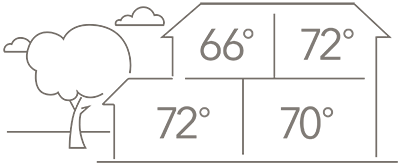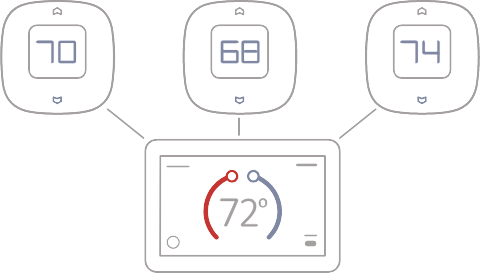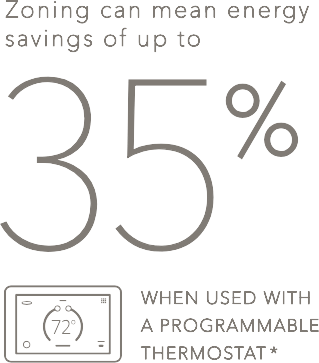Why do I need to zone my house?
 A well designed heating, venting and air conditioning zoning system can save you money and deliver year-round balanced comfort in your home. Zone system will provide separate control off air delivered to different areas of your residence, at different times of the day. As the sun proceeds across the sky during the day, the heating and cooling temperature load shifts with the sun. Is the top floor air warmer durring the summer vs lower levels of your home? – Zoning fixes this problem.
A well designed heating, venting and air conditioning zoning system can save you money and deliver year-round balanced comfort in your home. Zone system will provide separate control off air delivered to different areas of your residence, at different times of the day. As the sun proceeds across the sky during the day, the heating and cooling temperature load shifts with the sun. Is the top floor air warmer durring the summer vs lower levels of your home? – Zoning fixes this problem.
Compare your heating and cooling systems to the lighting in your home. You would never want your entire home lighting to be controlled by a single switch, would you? Same with zoning your home, each area will have its own thermostat to control the air in your home and eliminates the need for manual closing and opening vents which is a bad idea to begin with.
So why is your furnace and air conditioner controlled that way?
 Zoning your comfort system will give you the same control freedom that you have with your lighting!
Zoning your comfort system will give you the same control freedom that you have with your lighting!
Some homeowners claim a 30% savings in their heating and air conditioning operation costs after installation of an hvac zoning system. It makes sense! Why heat or cool areas of your home that you are not using? Or that you only use at a particular time of day, such as your Master bedroom.
With programmable thermostats controlling each zone, you can preset the time of day and preferred temperature, anticipating that your system will prepare the area before you retire for the evening. Temps in the other areas of your home will drop down until shortly before you wake in the morning.
If your plans change, you can simply override at the thermostat and start that zone back up.
Zoning also reduces the number of times a furnace or air conditioner cycles on and off during a 24 hour period. This not only saves money at the meters, but extends the life of your equipment.
An example
Let’s say that it is winter and your residence faces east. Your living room is on the east side and has large windows. In the morning, the east side of your home has a high heat gain due to the sun shining through the windows. Your thermostat is located here on the east side registering the morning heat gain. The west side of your home gets cold because of no sun hitting here yet. The furnace doesn’t come on-it’s not needed according to the thermostat over on the hot side of the home.
The same scenario applies to air conditioning. Different areas of a residence can call for cooling at different times of the day.
And as the sun has moved to the afternoon positions, the west side may not need as much heating, but the east side will need more. This hvac zoning system can accommodate the varying heating or air conditioning loads.
 An HVAC ZONE SYSTEM is like having a completely separate furnace and air conditioner for each area of your home.
An HVAC ZONE SYSTEM is like having a completely separate furnace and air conditioner for each area of your home.
Now, let’s apply this same concept to a multiple level home. Basements have totally different loads than main floor levels. And the same goes for upper levels. Too many multi-level homes are heated and cooled with a single furnace and air conditioner. Almost always the basement is too cold and the upper floor is always too hot.
The thermostat is usually located on the main floor. So, once the thermostat is satisfied by the temperature on the main floor, the furnace or air conditioner shuts down, regardless of the needs of the upper or basement level.
The same issue would be present if the thermostat was located in the basement or upper floor. The other levels would always be overheated or overcooled dependent upon the thermostat location.
The solution
is to provide the capability for different heating and cooling delivery to different areas of the home.
This can be accomplished with multiple small systems, or a main system with separate hvac zoning controls and dampened ductwork feeding different areas of your residence.
5 zones?
The best single system for the example above is one with 5 zones: A basement zone, a main floor east zone, a main floor west zone, and an east and west zone for the upper floor.
Installing 5 zones on a single system does bring about other problems, though.
First, you must have enough airflow through the evaporator coil for proper performance of air conditioner, or the system will freeze up. If a single zone calls for cooling, this problem can develop. A 2-stage outdoor condensing unit helps with this issue. A single stage air conditioner is a bad choice for a zoned system.
Second, single zones opening create high duct static pressure. This high static needs to be relieved for proper performance. A barometric bypass damper feeding a dump zone helps with this issue. An air handler or furnace with a variable speed blower or modulating is also a necessity for zoned systems.
Many equipment manufacturers offer 2-stage air conditioners, usually in their higher efficiency range. Most run at 60% of full capacity on first stage. They also offer variable speed air handlers, furnaces, and hvac zoning control boards which control blower speed separately for each zone.
Dual systems?
The above 5 zone system is an extreme example. It can be done, but this particular home may be better served with two heating and cooling systems.
One system would serve the main and basement with 3 hvac zones. The other system would probably be located in the attic, and serve the two upper zones. Of course, budget would be a driving factor for the dual system approach.
